| Listing 1 - 10 of 12 | << page >> |
Sort by
|
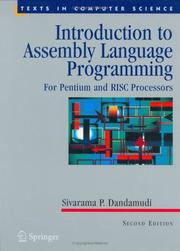
ISBN: 0387271554 0387206361 144191921X Year: 2005 Publisher: New York, NY : Springer New York : Imprint: Springer,
Abstract | Keywords | Export | Availability | Bookmark
 Loading...
Loading...Choose an application
- Reference Manager
- EndNote
- RefWorks (Direct export to RefWorks)
Assembly language continues to hold a core position in the programming world because of its similar structure to machine language and its very close links to underlying computer-processor architecture and design. These features allow for high processing speed, low memory demands, and the capacity to act directly on the system’s hardware. This completely revised second edition of the highly successful Introduction to Assembly Language Programming introduces readers to assembly language programming and its role in computer programming and design. It focuses on providing a firm grasp of the main features of assembly programming, and how it can be used to improve a computer's performance. The revised edition covers a broad scope of subjects and adds valuable material on protected-mode Pentium programming, MIPS assembly language programming, and use of the NASM and SPIM assemblers for a Linux orientation. All of the language's main features are covered in depth. The book requires only some basic experience with a structured, high-level language. Topics and Features: *Introduces assembly language so that readers can benefit from learning its utility with both CISC and RISC processors [ NEW ] *Employs the freely available NASM assembler, which works with both Microsoft Windows and Linux operating systems [ NEW ] *Contains a revised chapter on "Basic Computer Organization" [ NEW] *Uses numerous examples, hands-on exercises, programming code analyses and challenges, and chapter summaries *Incorporates full new chapters on recursion, protected-mode interrupt processing, and floating-point instructions [ NEW ] *Supplies up-to-date details, examples, and software via the author’s website *Provides excellent appendixes and a comprehensive index Assembly language programming is part of several undergraduate curricula in computer science, computer engineering, and electrical engineering. In addition, this newly revised text/reference can be used as an ideal companion resource in a computer organization course or as a resource for professional courses or self-study.
Assembler language (Computer program language) --- Microprocessors --- Programming. --- Assembler languages (Electronic computers) --- Programming languages (Electronic computers) --- Computer science. --- Computer hardware. --- Software engineering. --- Programming Languages, Compilers, Interpreters. --- Computer Hardware. --- Software Engineering/Programming and Operating Systems. --- Programming Techniques. --- Computer software engineering --- Engineering --- Informatics --- Science --- Assembly languages (Electronic computers) --- Programming languages (Electronic computers). --- Computer programming. --- Computers --- Electronic computer programming --- Electronic data processing --- Electronic digital computers --- Programming (Electronic computers) --- Coding theory --- Computer languages --- Computer program languages --- Computer programming languages --- Machine language --- Languages, Artificial --- Programming
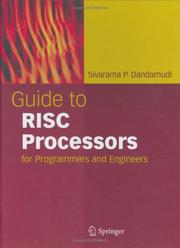
ISBN: 1280337230 9786610337231 0387274464 0387210172 144191935X Year: 2005 Publisher: New York : Springer,
Abstract | Keywords | Export | Availability | Bookmark
 Loading...
Loading...Choose an application
- Reference Manager
- EndNote
- RefWorks (Direct export to RefWorks)
Recently, there has been a trend toward processor design based on the RISC (Reduced Instruction Set Computer) model: Example RISC processors are the MIPS, SPARC, PowerPC, ARM, and even Intel’s 64-bit processor Itanium. This guidebook provides an accessible and all-encompassing compendium on RISC processors, introducing five RISC processors: MIPS, SPARC, PowerPC, ARM, and Itanium. Initial chapters explain the differences between the CISC and RISC designs and clearly discuss the core RISC design principles. The text then integrates instruction on MIPS assembly language programming, thereby enabling readers to concretely grasp concepts and principles introduced earlier. Readers need only have a basic knowledge of any structured, high-level language to obtain the full benefits here. Features: *Includes MIPS simulator (SPIM) download instructions, so that readers can get hands-on assembly language programming experience *Presents material in a manner suitable for flexible self-study • Assembly language programs permit reader executables using the SPIM simulator • Integrates core concepts to processor designs and their implementations • Supplies extensive and complete programming examples and figures • Contains chapter-by-chapter overviews and summaries * Provides source code for the MIPS language at the book’s website Guide to RISC Processors provides a uniquely comprehensive introduction and guide to RISC-related concepts, principles, design philosophy, and actual programming, as well as the all the popular modern RISC processors and their assembly language. Professionals, programmers, and students seeking an authoritative and practical overview of RISC processors and assembly language programming will find the guide an essential resource. Sivarama P. Dandamudi is a professor of computer science at Carleton University in Ottawa, Ontario, Canada, as well as associate editor responsible for computer architecture at the International Journal of Computers and Their Applications. He has more than two decades of experience teaching about computer systems and organization. Key Topics * Processor design issues * Evolution of CISC and RISC processors * MIPS, SPARC, PowerPC, Itanium, and ARM architectures * MIPS assembly language * SPIM simulator and debugger * Conditional execution * Floating-point and logical and shift operations * Number systems Computer Architecture/Programming Beginning/Intermediate Level.
Reduced instruction set computers. --- Computer architecture. --- Assembler language (Computer program language) --- Microprocessors --- Programming. --- Assembler languages (Electronic computers) --- Programming languages (Electronic computers) --- Architecture, Computer --- RISCs (Computers) --- Computers --- MMIX (Computer architecture) --- Computer science. --- Microprogramming. --- Software engineering. --- Computer network architectures. --- Processor Architectures. --- Control Structures and Microprogramming. --- Software Engineering/Programming and Operating Systems. --- Computer Systems Organization and Communication Networks. --- Programming Techniques. --- Computer software engineering --- Engineering --- Computer programming --- Informatics --- Science --- Architectures, Computer network --- Network architectures, Computer --- Computer architecture --- Microprocessors. --- Microprogramming . --- Computer organization. --- Computer programming. --- Electronic computer programming --- Electronic data processing --- Electronic digital computers --- Programming (Electronic computers) --- Coding theory --- Organization, Computer --- Minicomputers --- Programming
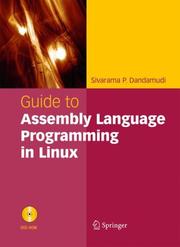
ISBN: 1280312106 9786610312108 0387261710 0387258973 Year: 2005 Publisher: New York : Springer,
Abstract | Keywords | Export | Availability | Bookmark
 Loading...
Loading...Choose an application
- Reference Manager
- EndNote
- RefWorks (Direct export to RefWorks)
This unique guide provides comprehensive coverage of the key elements of Assembly language programming with in-depth coverage of the Linux operating system, which is the fastest-growing operating system with an estimated 18 million Linux users worldwide. The book specifically targets professionals who would like to learn Assembly and intend or expect to move to the Linux operating system. This highly useful guidebook comes complete with all the necessary software (Linux, NASM, debugger), making it an extremely valuable resource tool for all those who want to learn Assembly programming and Linux. Readers need only have a basic knowledge of any structured, high-level language such as C to obtain the full benefits of this guidebook. Sivarama P. Dandamudi is a professor of computer science at Carleton University in Ottawa, Ontario, Canada, as well as associate editor responsible for computer architecture at the International Journal of Computers and Their Applications. He has more than two decades of experience teaching about computer systems and organization. Features and Benefits: • Free NASM assembler provides hands-on assembly language programming experience • Three chapters on computer organization provide the necessary background to program in assembly language • Presentation of material is suitable for self-study, with extensive programming examples and figures • All examples are complete in that they can be assembled and run, giving a better feeling as to how these programs work Key Topics: • Computer organization, including digital logic circuits, memory organization, IA-32 architecture • Installing and using Linux and NASM • Debugging assembly language programs • Overview of assembly language instructions • Writing procedures, addressing modes, conditional execution, logical and bit operations • Advanced assembly language, including string processing, ASCII and BCD arithmetic, recursion, protected-mode interrupt processing, high-level language interface, floating-point operations.
Assembler language (Computer program language) --- Linux. --- Slackware Linux --- SUSE Linux --- Assembler languages (Electronic computers) --- Programming languages (Electronic computers) --- Information Technology --- Computer Science (Hardware & Networks) --- Computer science. --- Software engineering. --- Programming Techniques. --- Programming Languages, Compilers, Interpreters. --- Software Engineering/Programming and Operating Systems. --- Software Engineering. --- Computer software engineering --- Engineering --- Informatics --- Science --- Computer programming. --- Programming languages (Electronic computers). --- Computer languages --- Computer program languages --- Computer programming languages --- Machine language --- Electronic data processing --- Languages, Artificial --- Computers --- Electronic computer programming --- Electronic digital computers --- Programming (Electronic computers) --- Coding theory --- Programming
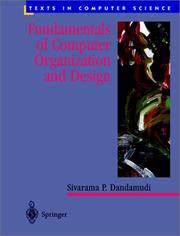
ISBN: 128018969X 9786610189694 0387215662 038795211X Year: 2003 Publisher: New York, NY : Springer New York : Imprint: Springer,
Abstract | Keywords | Export | Availability | Bookmark
 Loading...
Loading...Choose an application
- Reference Manager
- EndNote
- RefWorks (Direct export to RefWorks)
Computer science and engineering curricula have been evolving at a fast pace to keep up with the developments in the area. There are separate books available on assembly language programming and computer organization. There is a definite need to support the courses that combine assembly language programming and computer organization. The book is suitable for a first course in computer organization. The style is similar to that of the author's assembly language book in that it strongly supports self-study by students. This organization facilitates compressed presentation of material. Emphasis is also placed on related concepts to practical designs/chips. Topics and features: - material presentation suitable for self-study; - concepts related to practical designs and implementations; - extensive examples and figures; - details provided on several digital logic simulation packages; - free MASM download instructions provided; - end-of-chapter exercises.
Engineering. --- Computer hardware. --- Computer organization. --- Microprocessors. --- Electronics. --- Microelectronics. --- Electronics and Microelectronics, Instrumentation. --- Computer Systems Organization and Communication Networks. --- Processor Architectures. --- Computer Hardware. --- Computer network architectures. --- Computer science. --- Computer engineering. --- Minicomputers --- Organization, Computer --- Electronic digital computers --- Microminiature electronic equipment --- Microminiaturization (Electronics) --- Electronics --- Microtechnology --- Semiconductors --- Miniature electronic equipment --- Electrical engineering --- Physical sciences
Digital
ISBN: 9780387271552 Year: 2005 Publisher: New York, NY Springer Science+Business Media, Inc
Abstract | Keywords | Export | Availability | Bookmark
 Loading...
Loading...Choose an application
- Reference Manager
- EndNote
- RefWorks (Direct export to RefWorks)
Programming --- Computer architecture. Operating systems --- Computer. Automation --- computerbesturingssystemen --- hardware --- programmeren (informatica) --- programmeertalen
Digital
ISBN: 9780387274461 Year: 2005 Publisher: New York, NY Springer Science+Business Media, Inc
Abstract | Keywords | Export | Availability | Bookmark
 Loading...
Loading...Choose an application
- Reference Manager
- EndNote
- RefWorks (Direct export to RefWorks)
Digital
ISBN: 9780387261713 Year: 2005 Publisher: Boston, MA Springer Science+Business Media, Inc
Abstract | Keywords | Export | Availability | Bookmark
 Loading...
Loading...Choose an application
- Reference Manager
- EndNote
- RefWorks (Direct export to RefWorks)
Programming --- Computer. Automation --- computerbesturingssystemen --- programmeren (informatica) --- Linux --- programmeertalen --- software engineering
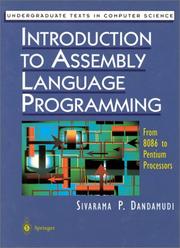
ISBN: 0387985301 Year: 1998 Publisher: New York : Springer,
Abstract | Keywords | Export | Availability | Bookmark
 Loading...
Loading...Choose an application
- Reference Manager
- EndNote
- RefWorks (Direct export to RefWorks)
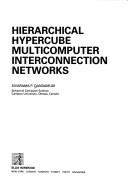
ISBN: 0134477987 Year: 1991 Publisher: New York London Tokyo Ellis Horwood
Abstract | Keywords | Export | Availability | Bookmark
 Loading...
Loading...Choose an application
- Reference Manager
- EndNote
- RefWorks (Direct export to RefWorks)
Book
ISBN: 9780387271552 Year: 2005 Publisher: New York, NY Springer Science+Business Media, Inc.
Abstract | Keywords | Export | Availability | Bookmark
 Loading...
Loading...Choose an application
- Reference Manager
- EndNote
- RefWorks (Direct export to RefWorks)
Assembly language continues to hold a core position in the programming world because of its similar structure to machine language and its very close links to underlying computer-processor architecture and design. These features allow for high processing speed, low memory demands, and the capacity to act directly on the system's hardware. This completely revised second edition of the highly successful Introduction to Assembly Language Programming introduces readers to assembly language programming and its role in computer programming and design. It focuses on providing a firm grasp of the main features of assembly programming, and how it can be used to improve a computer's performance. The revised edition covers a broad scope of subjects and adds valuable material on protected-mode Pentium programming, MIPS assembly language programming, and use of the NASM and SPIM assemblers for a Linux orientation. All of the language's main features are covered in depth. The book requires only some basic experience with a structured, high-level language. Topics and Features: *Introduces assembly language so that readers can benefit from learning its utility with both CISC and RISC processors [ NEW ] *Employs the freely available NASM assembler, which works with both Microsoft Windows and Linux operating systems [ NEW ] *Contains a revised chapter on "Basic Computer Organization" [ NEW] *Uses numerous examples, hands-on exercises, programming code analyses and challenges, and chapter summaries *Incorporates full new chapters on recursion, protected-mode interrupt processing, and floating-point instructions [ NEW ] *Supplies up-to-date details, examples, and software via the author's website *Provides excellent appendixes and a comprehensive index Assembly language programming is part of several undergraduate curricula in computer science, computer engineering, and electrical engineering. In addition, this newly revised text/reference can be used as an ideal companion resource in a computer organization course or as a resource for professional courses or self-study.
Programming --- Computer architecture. Operating systems --- Computer. Automation --- computerbesturingssystemen --- hardware --- programmeren (informatica) --- programmeertalen
| Listing 1 - 10 of 12 | << page >> |
Sort by
|

 Search
Search Feedback
Feedback About UniCat
About UniCat  Help
Help News
News